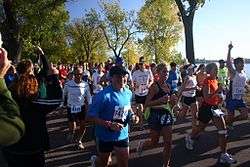Twin Cities Marathon


The Twin Cities Marathon (TCM) is an annual marathon in the Minneapolis-Saint Paul area. The race is often dubbed "The Most Beautiful Urban Marathon in America". The TCM was first run in 1982, and typically takes place during the first weekend in October. It is one of the top 10 largest marathons in the US. In 2006 the race agreed to its first corporate sponsorship, with Medtronic, Inc. The official name of the marathon changed in 2006 to Medtronic Twin Cities Marathon (MTCM).
In addition to the marathon, the MTCM has expanded to a full weekend of events providing opportunities for runners and wheelers of all ages and abilities. Sunday events for adults include the Medtronic TC 10 Mile, or "Shortcut to the Capitol". Medtronic TC Family Events take place on Saturday for children and adults of all ages. Saturday's races include the TC 10K, TC 5K, Diana Pierce Family Mile, Toddler Trot, Diaper Dash, and Mascot Invitational. In addition, Medtronic and the marathon's organizers sponsor a one-mile road race, for anyone from novices to professionals.
In 2006 the Twin Cities Marathon was ranked as the third most competitive marathon for American runners by Running Times magazine.[1]
In the 31 years since, the marathon has grown to a full weekend of events including the addition of the Medtronic TC 10 Mile race as a Sunday companion event to the marathon. On the Saturday before the marathon and 10 Mile, runners can compete in 5K and 10K runs and a variety of family events including the popular Diaper Dash and Toddler Trot events. [2]
History

The Minnesota Distance Running Association created the event’s earliest ancestor, originally called the Land of Lakes Marathon in 1975.[3] Spectators outnumbered runners that inaugural year as just five participants, all male, began the 26.2 mile trek along Minneapolis' streets and parkways.
In 1976, the race was renamed the City of Lakes Marathon and moved to a four-lap course around Lake Calhoun and Lake Harriet. By 1981, with the running boom echoing across the country, the race took just a month to fill its limit of 1,700 runners. In the same year, Minneapolis' counterpart established its own marathon, the St. Paul Marathon, which followed a course around Minnesota's capital city. The race launched successfully, drawing approximately 2,000 runners in its first and only running.
In 1982, organizers from the St. Paul and City of Lakes marathons combined efforts to establish the Twin Cities Marathon. Race officials realized that a marathon which connected Minneapolis to St. Paul, combining the spectacular autumn beauty of both cities, would be greater attraction than two competing marathons on either side of the Mississippi River. The inaugural Twin Cities Marathon attracted 4,563 entrants, which established an entry record for a first-time race in the United States.[4]
Course
The course begins at the U.S. Bank Stadium construction site in downtown Minneapolis, and winds around several of the city's lakes before turning along the banks of the Mississippi River. The course follows the river for several miles before crossing into Saint Paul, and then proceeds up Summit Avenue to finish at the Minnesota State Capitol. Miles 21–25 of the course proceed on a steady uphill from the river, and are considered among the more challenging finishes among American marathons, although the downhill last half-mile allows for relatively strong finishes.
Winners
| Key | CR= Course record |
See also
References
- ↑ "2006 Marathoners of the Year". Running Times. Retrieved 2007-12-22.
- ↑ "2013 Media Guide" (PDF). Twin Cities In Motion. Retrieved September 30, 2014.
- ↑ Winter, Jeff (October 2003). "City of Lakes Marathon 1975-1981: A Retrospective". City of Lakes Half Marathon. Retrieved October 6, 2014.
- ↑ "25 Years and Running... A Twin Cities Tradition Evolves". Medtronic. Retrieved 2007-12-22.
- ↑ "Ondoro Wins Twins Cities Marathon Again, In Record Time". CBS Minnesota. October 9, 2016.